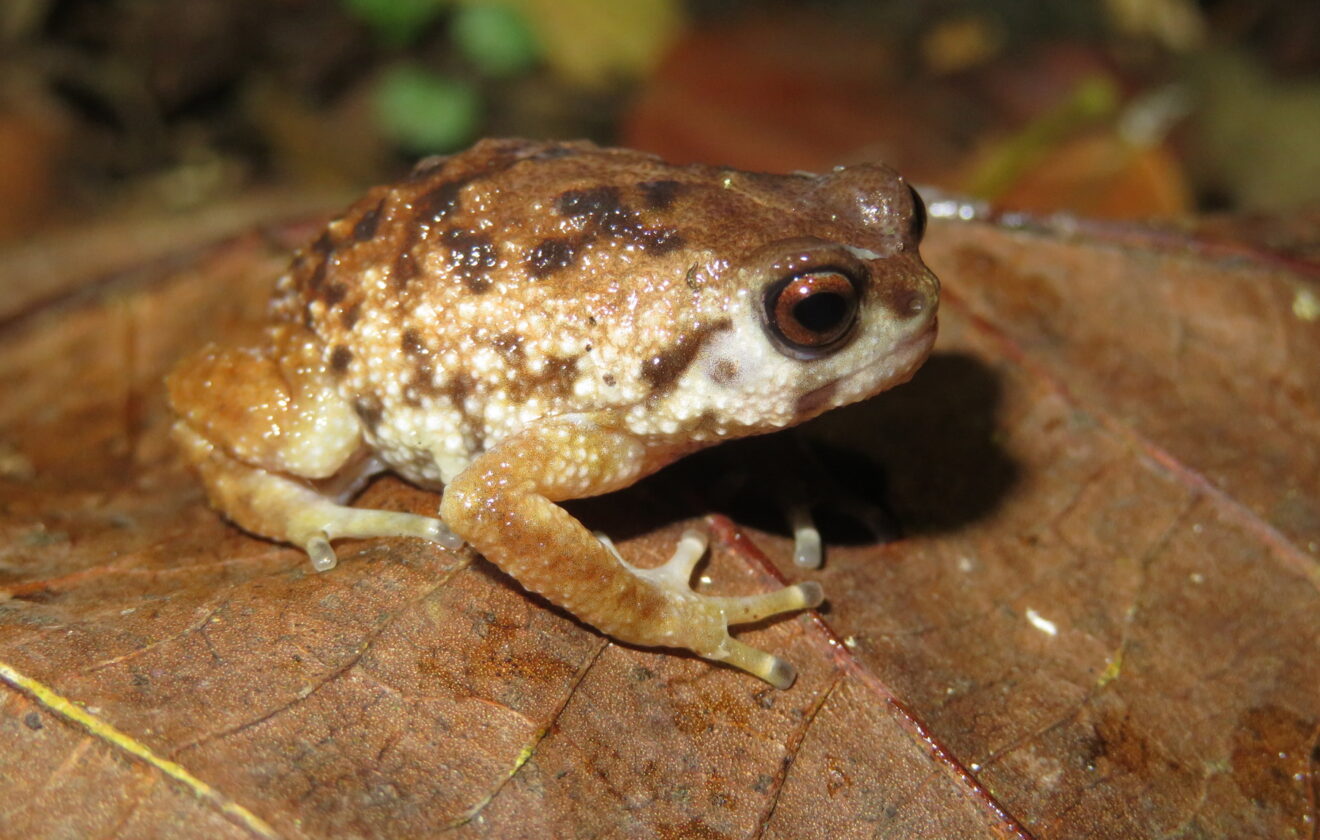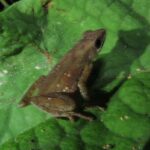- The Enchanting Callulina kisiwamsitu: Secrets of Tanzania's Forest Pebble Frog
- Taxonomy and Classification
- Natural Habitat: A Miniature World of Moss and Mist
- Physical Characteristics: Painting a Portrait in Camouflage
- Behavior and Life Cycle: Secretive Stages of Survival
- Ecological Role: The Silent Sentinels of Forest Health
- Threats and Conservation Status: Fragile Lives on the Edge
- Cultural and Scientific Significance: Treasures Worth Protecting
- Conclusion: Championing Tanzania’s Tiny Giants
The Enchanting Callulina kisiwamsitu: Secrets of Tanzania’s Forest Pebble Frog#
Hidden amid the lush emerald canopies and moss-covered trunks of Tanzania’s Eastern Arc mountains thrives one of nature’s miniature marvels, Callulina kisiwamsitu, also known as the Forest Pebble Frog. With its subtle patterns and curious, rounded shape blending seamlessly into the wet leaf litter, this species offers a fascinating glimpse into the richness of African biodiversity. Discovered only recently by eager herpetologists exploring the fragile montane forests, this small, secretive amphibian has swiftly become emblematic of the extraordinary yet often overlooked marvels of tropical forest ecosystems.
Despite their diminutive size and elusive character, these frogs serve as vital indicators of ecological health, their very existence highlighting the intricate web of relationships that support thriving forest habitats. Join us as we journey into the secluded world of Callulina kisiwamsitu, unveiling the biology, habits, and challenges faced by these captivating creatures.
Taxonomy and Classification#
The Forest Pebble Frog, Callulina kisiwamsitu, belongs to the family Brevicipitidae, a group of frogs known for their rounded, compact shapes and terrestrial lifestyles. The genus Callulina comprises a small number of species that demonstrate remarkable adaptability to montane forest conditions. First properly described by Loader et al. in 2010, Callulina kisiwamsitu has sparked interest among taxonomists and conservation biologists eager to understand its exact placement within the broader amphibian landscape.
Closely related to other forest-dwelling Callulina frogs, such as Callulina dawida and Callulina stanleyi, it exhibits distinctive morphological and genetic characteristics that set it apart. These subtle differences underscore Tanzania’s Eastern Arc Mountains as a region of significant amphibian diversification, providing critical insights into the evolution of life in unique and rapidly-changing ecosystems.
Natural Habitat: A Miniature World of Moss and Mist#
Inhabiting the verdant slopes of Tanzania’s isolated Eastern Arc forests, Callulina kisiwamsitu is finely attuned to its environment. Specifically, it requires the cover and humidity provided by montane rainforest, thriving among moss-laden logs, damp leaf litter, and shaded, richly vegetated understories. Their habitat is shrouded frequently by swirling mountain fog and abundant rainfall, creating near-constant moisture that sustains these fragile amphibians.
This frog is endemic to the Ukaguru Mountains, an isolated range within the Eastern Arc landscape, rising like birthmarks off Tanzania’s central plateau. Here, at elevations typically between 1,600 and 2,200 meters, dense, mist-shrouded forests offer ideal refuges for amphibians adapted to cool, humid conditions. Beneath slender canopies of towering trees and among tangled vines and lichens lies a hidden universe bustling with life—from tiny insects and arachnids to stealthy predators—creating the perfect stage for this pebble-like species to flourish.
Navigating this shaded, humid world, Callulina kisiwamsitu leaves minimal footprint. Its cryptic coloration and compact physique facilitate camouflage among the intricate textures of humid forest floors, where it patiently awaits prey, safe from the gaze of predators skimming the forest floor.
Physical Characteristics: Painting a Portrait in Camouflage#
Callulina kisiwamsitu tells a visual story of adaptation in form and coloration. Measuring only about 2-3 centimeters in length, these frogs embody subtlety itself. Their rounded, pebble-like bodies—with short, muscular limbs—appear almost sculpted from the very leaf litter that surrounds them, allowing seamless blending with their environment. Their backs feature a mosaic of muted earthy tones—brown, olive, ochre, and warm gray hues—with irregular darker patches and spotting patterns that mimic the texture of decaying leaves or damp bark, enhancing their cryptic strategy.
Their skin texture is granular yet smooth enough to discourage detection and minimize moisture loss. Large, expressive eyes positioned prominently on their rounded head grant them excellent peripheral vision, crucial for predator avoidance and prey identification. Despite their diminutive size, the stout legs of Callulina kisiwamsitu are perfectly adapted for navigating slow, steady movements amidst leaf litter rather than making large leaps, characteristic of other frog species.
Uniquely adapted to their terrestrial lifestyles, their toe tips lack pronounced webbing, allowing greater precision and control as they climb softly over textured forest surfaces. Together, these features have evolved over millennia to ensure their survival in an environment full of potential perils and limited opportunities.
Behavior and Life Cycle: Secretive Stages of Survival#
Feeding Habits and Diet#
Hidden from view beneath the shaded canopy, Callulina kisiwamsitu plays an active role as a predator of numerous small invertebrates. The diet primarily comprises ants, termites, small spiders, and occasionally small beetles and larvae. Employing a sit-and-wait hunting strategy, these frogs remain remarkably still and observant, waiting patiently until potential prey moves within striking distance before deftly snatching their meal with precise and rapid movements of their sticky tongues.
Mating and Reproductive Behaviors#
The reproductive behaviors of Callulina kisiwamsitu are among the most intriguing and least understood elements of their biology, owing to their elusive nature. It is known through related species in the genus that they utilize direct development, bypassing the aquatic tadpole stage entirely—a significant adaptation for life in their damp terrestrial habitats where water bodies may be scarce or ephemeral.
Males emit soft yet distinctive calls during mating seasons—low-pitched chirps and whistles resonating faintly through the forest’s dense vegetation—to attract potential mates. Courtship occurs discreetly in hidden niches and leaf litter cavities, minimizing exposure to predators and environmental disturbances. Females subsequently produce small clutches of fertilized eggs directly onto moist substrate or under organic debris, carefully guarding their developing offspring until they hatch as miniature froglets. Such parental care behaviors are reflective of the incredible intimacy and caution these amphibians reserve for their offspring’s protection in a perilous environment.
Ecological Role: The Silent Sentinels of Forest Health#
The presence and well-being of species like Callulina kisiwamsitu lend profoundly valuable insights into forest ecosystem integrity. Amphibians represent bio-indicators, organisms whose subtle sensitivities to environmental fluctuations provide early warning signs regarding ecological change or degradation. As predators, they’re instrumental in regulating insect populations, fulfilling their nuanced niche in the forest food web and supporting ecosystem equilibrium.
Conversely, they are prey to several bird, reptile, and mammal predators, serving as critical links within the forest’s highly interconnected biodiversity network. Each subtle shift within their population numbers or distributions may imply consequential environmental shifts that impact the broader forest ecosystem, highlighting their value as vital checkpoints for biologists and conservationists.
Threats and Conservation Status: Fragile Lives on the Edge#
Despite their adaptations, Callulina kisiwamsitu confronts escalating threats primarily driven by human activities. Habitat destruction, largely from logging, agricultural expansion, and charcoal production, fragments and degrades essential forest landscapes. Climate change exacerbates these threats, raising temperatures, altering rainfall patterns, and diminishing vital forest moisture that sustains their unique ecological niches.
Currently assessed as “Critically Endangered” by the International Union for Conservation of Nature (IUCN), the Forest Pebble Frog urgently demands conservation attention. Protective measures in the Ukaguru Mountains, such as habitat restoration initiatives and improved local stewardship, are vital to ensuring this species’ survival into the future.
Cultural and Scientific Significance: Treasures Worth Protecting#
Beyond their ecological roles, species like Callulina kisiwamsitu remind us of nature’s endless creativity and resilience. Their presence symbolically emphasizes the hidden richness of biodiversity and importance of safeguarding fragile ecosystems from irreversible damage.
Scientifically, these frogs offer invaluable insights into evolutionary adaptation, environmental change, and conservation science research. Each new discovery regarding their biology illuminates vital aspects of amphibian life and ecosystem health, reinforcing conservation significance beyond mere scientific curiosity.
Conclusion: Championing Tanzania’s Tiny Giants#
The quiet charisma, unique adaptations, and precarious survival challenges of Callulina kisiwamsitu remind us of the importance of vigilant and proactive conservation. Let these miniature forest guardians serve as ambassadors for Tanzania’s precious ecosystems and inspire us all to support efforts protecting these remarkable landscapes and their extraordinary inhabitants.








